#diversity jurisdiction
Text
My Legal Battle with my Family and their Co-horts / Co-conspirators (1):
I was released from prison on February 27, 2013. The same day I started talking to a man on the phone named Creighton Hussey. For 6 weeks we talked every night on the phone for 2 hours. He told me everything I wanted to hear. He feigned interest in the same relationship values I have and to want the same things out of life and a relationship that I want. He then scheduled a work trip to Atlanta so that he could come and see me. Things went really well, or so I thought, and as soon as he pulled out of my apartment parking garage to go back to the airport I received a text message from Abb Jones. Abb is someone I hadn’t heard from in several years. In fact, the last time I had heard from Abb was in 2006 when he invited me over to his house to swim, he tried to sleep with me and I turned him down. Abb texted me stating that he had seen a Facebook post I made where Creighton and I had been at Piedmont Park earlier the same day walking John Flynn’s dog, Braxton.
John had left a key for me and asked me if I could walk his dog for him while he was allegedly out of town. I didn’t think anything of it. (It’s important to note here that when I went to prison in 2008 I hadn’t talked to John Flynn in more than 2 years because he ended his friendship with me because he was dating someone and while a big group of us were at brunch together, to which John had invited me, he accused me of talking to his boyfriend in an improper manner. Although I did nothing wrong and did not do anything but have a conversation wtih his boyfriend because his boyfriend sat next to me at a table of of about 20 people. I was just being polite and friendly. I would never hit on a friend’s boyfriend or anyone else’s boyfriend for that matter. It’s also important to note here that it was in fact my parents that put John Flynn back in my life. When I went to prison, John Flynn and my parents somehow began talking and John Flynn even drove all the way to Vancleave, Mississippi to my parents house to “have pecan pie.” This is a 6 hour drive from Atlanta where John Flynn lived and I wasn’t even told that it was happening until after it had happened. I will show proof of this as I have a sworn statement from my parents that this did in fact happen.)
So when Abb Jones texted me just as Creighton Hussey drove off from my house in April 2013, Abb asked if Creghton Hussey had been in town to see me. I texted Abb back that yes Creighton was in town to see me. Abb then texted me and said that he and Creighton had been talking every night on the phone for 2 hours a night. I texted Creighton to ask him about it and he told me that he had met Abb on the nude beach in Fort Lauderdale but that they were not talking and that Abb was just mad because Creighton was interested in me and not him. I trusted Creighton and didn’t think much of it. This seemed logical especially since I hadn’t talked to Abb since the day I turned him down for sex so I believed Creighton.
#social media stalking#privacy#craig sumter#Shalene Sumter#Shalene Ryall#gloria sumter#leonard sumter jr#creighton hussey#barry creasman#dennis bickhim#john ryall#tim gehret#amy waltman#justice#the good fight#ronnie sumter#jeff hebert#dave euckland#diversity jurisdiction#28 U.S.C. 1332#42 U.S.C. 1985#O.C.G.A. 51-1-6#O.C.G.A. 51-1-8#O.C.G.A. 51-1-13#O.C.G.A. 51-1-14#Destruction of Evidence#Tampering With a Witness#Online Bullying#Stalking#Terroristic Threats
5 notes
·
View notes
Text
‘omg not all of us’ is never like the best way to deal with that obviously but like idk it grinds on the nerves and u just wonder how anyone is this bad at recognizing when they’re just recycling garden variety transphobia themselves
#‘don’t ever listen to trans men or take them seriously bcuz they’re Probably a transmed or smth’ gee i wonder who that benefits#since ppl have said that abt me every time i bring up transphobia and ppl just believed it bcuz he’s a trans man so Probably lol u know how#they r! i have intimate experience w exactly what kind of ppl would Love for you to not take an entire diverse community of oppressed ppl#seriously. but idk 🥰 maybe i rly am just an immature whiny sensitive idiot who doesn’t know what’s best for me and needs other ppl to#protect me from myself#don’t u know it is actually Good to say that anyone who was born w the same parts has automatic jurisdiction and control over ur entire#body life and what experiences you Actually have and ways you’re allowed to talk abt them
1 note
·
View note
Text
World Map Notes: the Elven Northern & Southern Central Continents
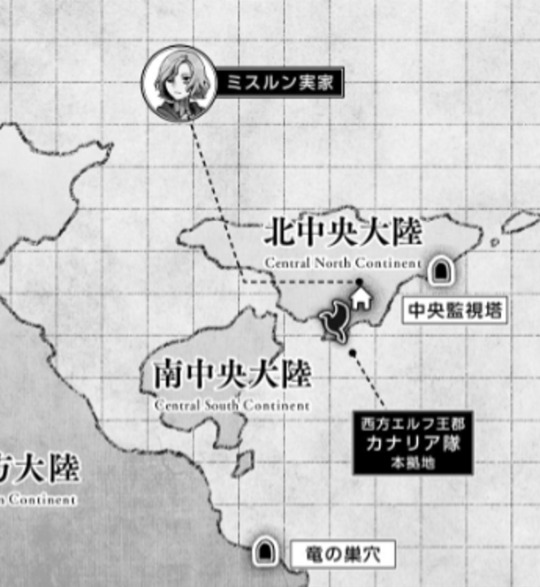
These nations are where all the elves in the story except Marcille and Thistle are from. This post collects all the information I could find about these two nations, and included a bit of analysis based on that information.
TL;DR (includes both fact and my speculation):
The Northern Central Continent is a feudal monarchy with a strong class system, as well as strict borders, & could probably be considered an ethnostate. It's deeply hierarchical, and the queen is a traditionalist - so it's probably very structurally biased against non-elves and half-elves.
Elves in the NCC practice cannibalism in some rural areas!
The Southern Central Continent is more diverse, with a large tallman population on its South Coast.
To elves, "Court Magicians" exclusively refer to those serving the elven queen - a prestigious role that seems likely to be only open to nobles.
The SCC may not be a monarchy, though it's not clear what kind of leadership or societal structure it does have.
The NCC will habitually take anyone involved in ancient magic as a criminal to prosecute on their terms, regardless of jurisdiction, but this depends on their political influence and ability to pressure local leaders to agree to extradite the criminal.
Elves VS Dwarves and Gnomes may have been at war around the time of the Golden Kingdom being sealed. This conflict also may be one of the factors pushing the kingdom to be sealed in the first place.
The "Central Region" might be the origin of the "Common Tongue" that our characters speak.
Northern Central Continent
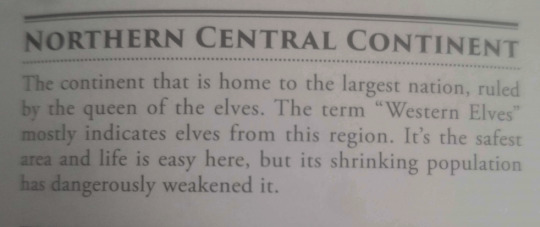
The Adventurer's Bible | p. 132
For this place to have a high quality of life, and also a declining population - especially when it's so close to the Western Continent, which is stated to have poor quality of life - there must be strictly maintained borders and a strong anti-immigration policy. Based on the attitude of the elves, I wouldn't be surprised if it was very difficult to move there unless you are also an elf.
It could probably be considered an ethnostate - and while in these kinds of fantasy worlds, that's pretty common. Take Rivendell, or Moria, in LOTR - they take for granted that these kinds of different fantasy races will live in separate communities.
But that isn't actually realistic, and I think Kui has considered it as more of a politically established status quo rather than an obvious natural result of having magically distinct "races". Which, even in Dunmeshi, I think is a difficult and not-terribly-accurate way to represent politics - racism does not emerge from actual, physical differences between races, after all.
But Dunmeshi's presentation of this idea is interesting, because of the recognition that if there is an "elven nation" which prioritises the interests and rights of elves over other races, that is because there's a deliberate, concerted effort to keep it that way.
But there's a small section of the NCC with a high tallman population - I wonder what kind of community they have, and how they fit into the strict elven hierarchy?
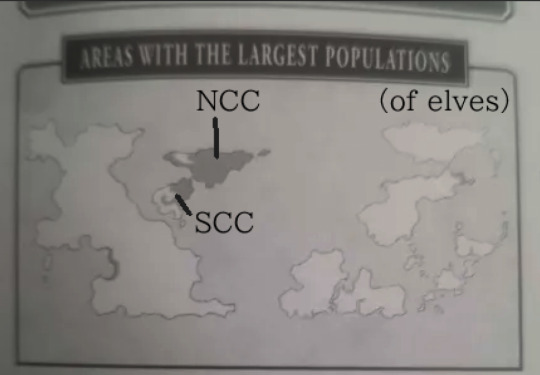

The Adventurer's Bible | pp. 134 & 136
Kabru and Rin, and other kids like them, who are adopted or taken as adopted children(rarely - the way Milsiril treats Kabru is not perfect, but she's deliberately attempting to be better than other elves.... meaning other elves are usually worse)/pets/objects by elven nobles, as well as accomplished or notable individuals who earn the elves' favour/are "invited" to stay (such as they try with Laios at the end of the story) would be an exception.
Other long-lived races could probably (...?) visit, but given the historical conflict between elves, dwarves, and gnomes, I think they'd also be pretty hostile to many of them coming to live on the NCC, even if they see them as more like equals.
Social Structure & Nobility
The Northern Central Continent is an absolute monarchy under a 372 year old queen, Heimeya (IDK what the official romanisation of her name will be).
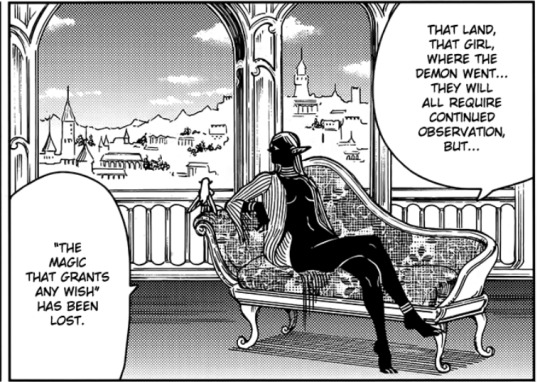
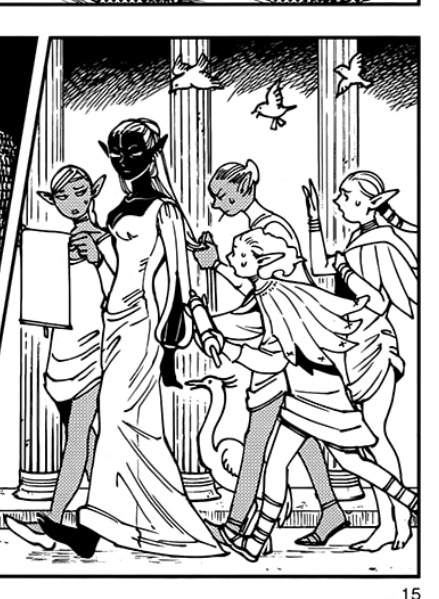
...With extended "nobility", which are the group that the canaries' guards draw from. We don't get much clarification of what sort of structure their nobility has, what titles there are, and where our characters who are nobles fall into it.
Pattadol (House of Vari), Mithrun (House of Kerensil), and Milsiril (House of Tol) are nobles.
Mithrun's noble house, Kerensil, is apparently a well-known family of investors! I wonder what sorts of businesses they invest in & what the elven economy is like?
Milsiril's house, on the other hand, is a well-known military family. I wonder if Kabru could claim the surname "of the House of Tol". He did go to family gatherings after all. But if he was comfortable doing so and it would be accepted, I would assume he'd have done so when introducing himself to the canaries.
Flamela is a distant relative of the queen, who has additional status due to exhibiting the genetic trait associated with their queens, extremely dark skin.
The queen is a "staunch traditionalist" who wouldn't even acknowledge a half-elf like Marcille. Nice! I really feel bad for Kabru and Rin growing up as tallmen in this sort of culture.
Court Magicians
While generally this is a term for any magic user who serves in a royal court, in the Northern Central Continent it seems to carry a lot of esteem; even just as the daughter of one, Pattadol assumes Marcille has the right to boss her around and to handle highly secret, highly illegal ancient magic secrets.
That makes sense, as in the society of the Northern Central Continent, you'd be directly serving the elven queen. But also, she has enough Court Magicians that Pattadol would not expect to know Marcille's mother's name, but few enough that it would be a big deal and Cithis would know about it if one had a half-elf child.
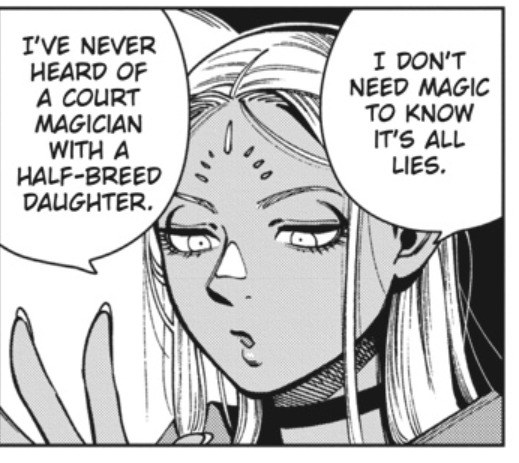
I don't think it's remotely unlikely based on that to assume that this role is only available to nobles.
A "Court Magician" who doesn't serve the NCC Queen isn't a "real" Court Magician in the eyes of NCC elves. Those short-lived monarchs would be happy just to have an elf around regardless of whether they were actually any good at magic.... according to Cithis.
Magic seems very important to the society of the NCC elves. The queen communicates with her subordinates via familar, and the birds we see surrounding her seem like they are some kind of magic - perhaps not familiars since we see her familiar, but some other kind of scrying?
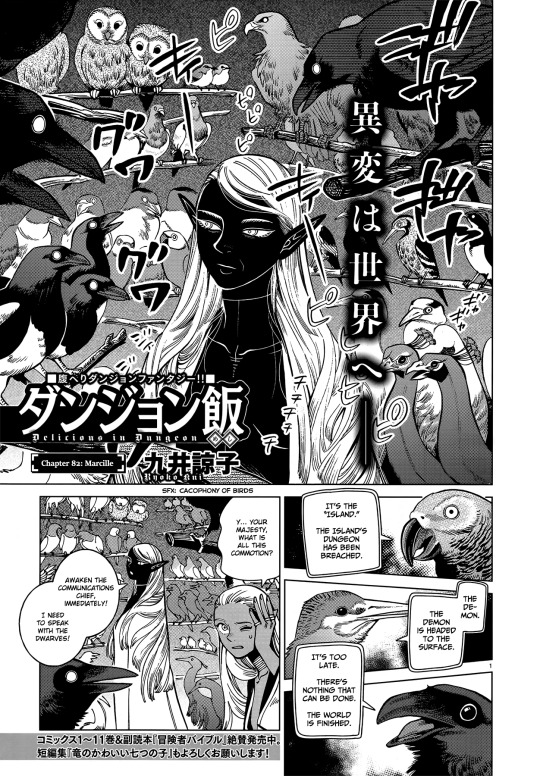
Also, based on the fact Pattadol assumes a Court Magician would be serving the Queen of the NCC, we can theorise that perhaps whatever structure the SCC has, it isn't a monarchy....? Heimeya is "the queen of the elves", after all - that doesn't sound like there's another elven monarch competing for the title just next door.
Ordinary People
Apparently the NCC is a safe place and life is easy -- but given the strict class system, I kind of expect that varies a lot depending on the family you're born into.
The only elves we meet who are not nobles are the convicted criminal canaries, so it's hard to get a sense of what life is like for them from that. Cithis was apparently a wealthy fortune teller with "an intense jealousy for those born noble or wealthy." So I assume she was not born into comfort.
Apparently "There are also primitive villages deep in the woods and underground, and in some regions cannibalism is still practiced." Which is awesome. Based on her videogame elves art I think Kui's probably making a little nod to Divinity: Original Sin elves, who can absorb memories through eating the flesh of others. Elves in dungeon meshi don't have this trait, but I wonder if there is a magical ritual or some kind of cultural practice with a similar intention.
Cuisine
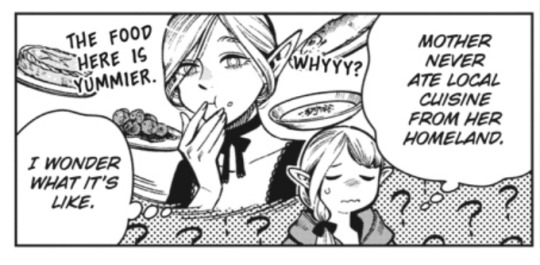
Marcille's mother didn't think much of the elven cuisine.
Liricmumwarel is fancy candy given out by the elven queen the shape of which conveys blessings.
Elf Cake is a crumbly dry cake that Kabru and Thistle don't think much of. I've heard someone discuss what it's likely to be made of, but I am afraid I don't recall.
Southern Central Continent

The Adventurer's Bible | p. 132
It seems like the Southern Central Continent gets a lot more immigration and has a more diverse population, especially along the south coast (near the Western Continent). That south coast has a high tallman population.
Fleki and Lycion are from the Southern Central Continent. Fleki got into ancient magic for the money, so you can assume there's probably class disparity there too; things are noted by Kui to be more "disorganised" than the NCC. Not a bad thing at all - the NCC is definitely too "organised" in my books. But that does potentially also mean there's less, e.g., bureaucracy, central organisation, less of a social safety net. But then again, in the NCC I doubt that whatever "safety net" there is, is available to everyone.
We can't extrapolate much from Fleki & Lycion's personalities, because they clearly aren't in the most stable societal position, and I get the sense that they're the countercultural type - they probably don't represent the type of person typical to the SCC. Also, our NCC characters are all either nobles or used to navigating high society (Cithis, Kabru to an extent) so they aren't exactly a typical "ordinary NCC person" as a basis for comparison either. However, there's less of a "strict set of social rules" type of feel to the SCC characters, fitting with my suggestion that the SCC may not be a society with a strong feudal element.
Geopolitics & Conflict
The fact that, despite their being from the SCC, Fleki and Lycion are in the Canaries, who work directly under the NCC's Queen, implies that the the NCC feel entitled to process and prosecute people who commit ancient magic-related crimes regardless of any notion of "jurisdiction". This is backed up by the way that they were going to take Marcille - but that is something that the governor of the Island had to give permission for, which Laios is able to withdraw. So I assume that the NCC elves apply pressure on various world leaders to extradite criminals involved in ancient magic.
The SCC would cooperate with this, since they're allies, even if they don't have a great relationship (according to the World Guide).
The NCC are also clearly able to take half-foots without trouble, as we see by Chilchuck saying he's known half-foots who got involved with "black magic" (ancient magic) and were disappeared by the elves. But I doubt gnomes or dwarves are giving people up easily - though that probably doesn't go for dwarves like Senshi and Namari, without strong community ties.
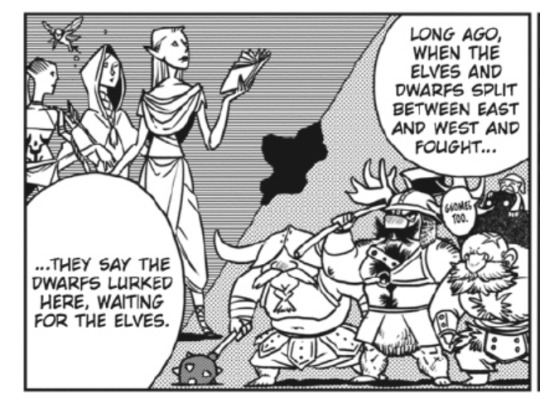
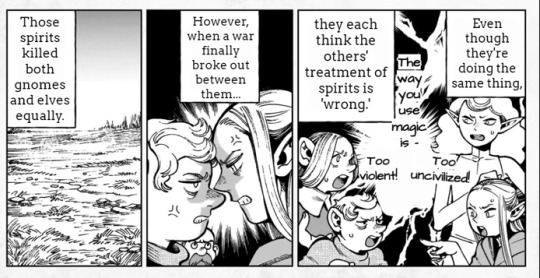
Long before the current times, elves fought dwarves & gnomes. There might have been more than one of these conflicts...? While long ago, this war isn't "ancient" (like the ancients who sealed the demon into dungeons, before their world was mostly destroyed by it).
Thistle, Delgal, and the Golden Kingdom were (I believe) caught up in one of these conflicts, which used Melini as a staging ground - thus why Thistle was pushed to seal the entire kingdom in the dungeon.
To do this, Thistle unseals a dungeon created by the "ancient people". These could be the "ancients" who created the dungeons, before the apocalypse. Or they could be another, still extinct, society.
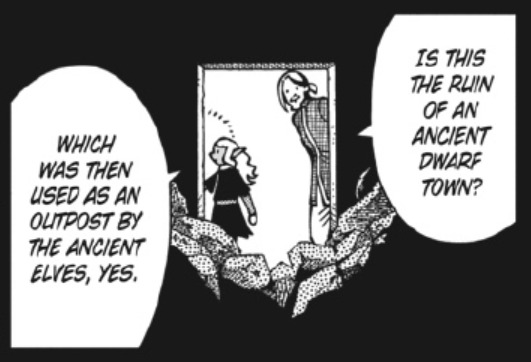
Regardless, at least one of these conflicts seems to have taken place after the golden kingdom was sealed - so, within the last 1000 years.

Though, this could refer to a different, more localised conflict between the Golden Kingdom and their dwarven neighbours.
The order of events is that the Golden Kingdom was sealed (1000 years ago or so) > Dwarves took over > Elves stole the land from the Dwarves ("long ago" by the Island Lord, a tallman's, standards) > Elves gave the land to a local lord, who was either an ancestor of the Island Lord, or the Island Lord himself. The Island Lord is himself a descendant of the lord who poisoned Delgal's father, as is noted in the World Guide. However, it isn't impossible for there to be large gaps of time between these events, which could put the elf / dwarf wars at a more recent date.
The fact we know that the elves stole the land from the dwarves, and then granted it to a political actor who was relevant during the events of the Golden Kingdom flashbacks we see suggests to me that the events were roughly contemporaneous. If they were, that puts at least one of these conflicts at roughly 1000 years ago.
So, the elf/dwarf & gnome conflict is "long ago" by short-lived standards, but would be considered "modern" by the long-lived races, if you ask me. At least, the equivalent of the World Wars for us - recent history, even if we weren't alive.
I'm guessing the "Elf King" from the below panel in fact was a word that's more gender-neutral in Japanese, since the "Western Elves" definitely have a queen.

Language
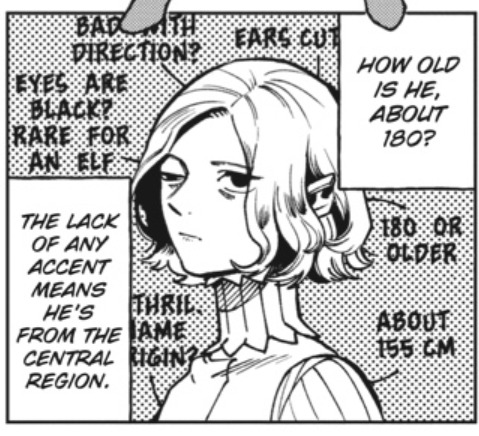
When Kabru says the "Central region" I expect he means the region where the NCC and SCC is.
The fact that he observes that the lack of any accent means he's from the Central Region is really interesting. It could mean two things;
either they switched to speaking in the language spoken on those continents, which Kabru would naturally know, having grown up there. It's 100 percent possible, but I think this would be noted in the story.
or, the language that gets called "the common tongue", the one that all our principle characters speak for most of the story, originated from the elves in the Central Continent. Or at least it's the same one that the elves use, and their political influence is great enough that their accent gets to be considered not an accent at all. The fact they were "granting" land in this area to tall-man lords suggests a large enough historical influence in the area that this is quite plausible to me.
Mithrun absolutely does have an accent - nobody speaks without an accent. His accent is just politically and socioculturally normalised to the point of being considered the "default/proper" way to speak - like received pronounciation in English.
The common tongue isn't ubiquitous everywhere - not just Kuro, but Kiki and Kaka are also noted to be studying the common tongue. The Tansus were born on the Eastern Continent, so probably gnome communities there speak their own language - Kiki and Kaka grew up primarily surrounded by gnomes after all.
It's also quite likely that Kabru, specifically, because of where he grew up, would consider Mithrun's way of talking to be the default "not an accent" accent. His adoptive mother surely has the same upper-class NCC accent. I expect that other characters might experience it as more "marked".
This isn't a world where everyone speaks the same language everywhere; the common tongue is called that, but there are many different languages. Kabru and Chilchuck are two characters who are adept with many of them - Kabru speaks the language of the kobold, and probably lots more. Chilchuck works as an interpreter as part of his union stuff - I can tell you from experience that that's a hugely valuable skillset in that context, as many of the people who most need union representation are people who don't speak the dominant language, or at least not fluently.
If you got all the way to the end of this post.... thank you for reading, I love you. Check out my other World Map Notes under that tag on my blog; I've made a few so far and there will almost certainly be more. Next I'm thinking the dwarven nations...? But I could be persuaded if someone had a preference.
Also, anyone got any speculation on what, exactly, is the previous time that Heimeya ate a person/monster/chimera that this panel implies:

We really don't have anything to go on whatsoever, but I think it's a fun tidbit.
#og post#dungeon meshi manga spoilers#dungeon meshi meta#dunmeshi#dungeon meshi analysis#delicious in dungeon spoilers#dunmeshi spoilers#delicious in dungeon#dunmeshi meta#the canaries#milsiril#mithrun#kabru of utaya#i feel sooooooo sane to have made this. but it has some super interesting details imo#colour coding only on the TLDR just cause I dont want ppl to take my theories as fact#character info I drop without a panel comes from the world bible#world map notes
268 notes
·
View notes
Text
—
“the U.S. Supreme Court rejected the State of Alaska’s bid to fast-track the legal process, overrule the Environmental Protection Agency (EPA), and gain approval for the Pebble Mine — slated to extract enormous amounts of copper, gold, and molybdenum from the pristine and sensitive ecosystem known as Bristol Bay.
A diverse coalition led by Alaska Natives has consistently fought against the proposed mine for more than two decades. It eventually gained support from the EPA, which ultimately blocked the mine proposal in January 2023 over concerns it would threaten an aquatic ecosystem supporting the world’s most prolific sockeye salmon fishery.
This decision is significant, particularly considering the current High Court’s tendency to support states’ rights, limits on regulation — especially of the environmental variety — and corporate concerns. Alaska’s request, filed in June, was unusual in that it sought to skip lower appeals courts to challenge the EPA’s decision on the basis that it violated Alaska’s state sovereignty.
Under the law, alleged violations of state sovereignty are one of the few categories of cases that grant the Supreme Court original jurisdiction — meaning a state can bypass the usual state/federal court appeals process and file straight with the High Court. The justices could easily have decided to hear the case and decide in favor of the mining company, which has shown no qualms about engaging in some shady business practices over the years.
As the single most productive sockeye salmon fishery in the world, Bristol Bay contains biodiversity and abundant wild fish populations which present a stark contrast to many other fisheries in the Pacific Northwest (and worldwide). Most have experienced severe depletion over the last few decades. Sockeye salmon — like all Pacific Salmon — are a keystone species, vital to the health of an entire ecosystem. Of course, salmon also provide a sacred food source for Indigenous communities up and down the West Coast.”
-from the Lakota People’s Law Project
#good news#environmentalism#nature#environment#environmental law#environmental justice#indigenous activism#conservation#fish#salmon#usa#alaska#alaska natives
380 notes
·
View notes
Text
“More than four months ago, the Prosecutor of the International Criminal Court asked me to assist him with evaluating evidence of suspected war crimes and crimes against humanity in Israel and Gaza. I agreed and joined a panel of international legal experts to undertake this task. Together we have engaged in an extensive process of evidence review and legal analysis including at the International Criminal Court in The Hague.
The Panel and its academic advisers are experts in international law, including international humanitarian law and international criminal law. Two Panel members are appointed as expert ‘Special Advisers’ by the Prosecutor of the International Criminal Court. Two Panel members are former judges at criminal tribunals in The Hague.
Despite our diverse personal backgrounds, our legal findings are unanimous. We have unanimously determined that the Court has jurisdiction over crimes committed in Palestine and by Palestinian nationals. We unanimously conclude that there are reasonable grounds to believe that Hamas leaders Yahya Sinwar, Mohammed Deif and Ismail Haniyeh have committed war crimes and crimes against humanity, including hostage-taking, murder and crimes of sexual violence. We unanimously conclude that there are reasonable grounds to believe that Israeli Prime Minister Benjamin Netanyahu and Israeli Defense Minister Yoav Gallant have committed war crimes and crimes against humanity including starvation as a method of warfare, murder, persecution and extermination.
I served on this Panel because I believe in the rule of law and the need to protect civilian lives. The law that protects civilians in war was developed more than 100 years ago and it applies in every country in the world regardless of the reasons for a conflict. As a human rights lawyer, I will never accept that one child’s life has less value than another’s. I do not accept that any conflict should be beyond the reach of the law, nor that any perpetrator should be above the law. So I support the historic step that the Prosecutor of the International Criminal Court has taken to bring justice to victims of atrocities in Israel and Palestine.
Today, my colleagues and I have published an oped and a detailed legal report of the Panel’s findings. My approach is not to provide a running commentary of my work but to let the work speak for itself. I hope that witnesses will cooperate with the ongoing investigation. And I hope that justice will prevail in a region that has already suffered too much.”
—AMAL CLOONEY, Barrister and Co-Founder of the Clooney Foundation for Justice
#politics#amal clooney#palestine#israel#war crimes#benjamin netanyahu#benjamin netanyahu is a war criminal#israel is a terrorist state#settler violence#settler colonialism#crimes against humanity
178 notes
·
View notes
Photo
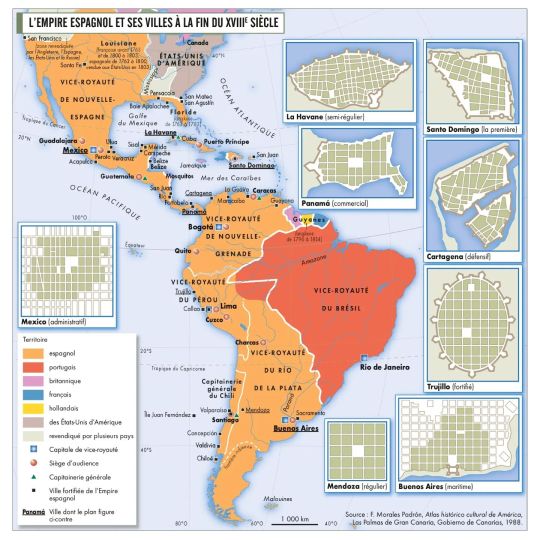
Spanish America
"Atlas des premières colonisations", Autrement, 2013
by cartesdhistoire
74 notes
·
View notes
Text
CCGSD (Canadian Center for Gender and Sexual Diversity) is calling on all of their supporters to contact their provincial and municipal representatives and demand they support their trans constituents by signing onto this pledge.
Pledge of Pride:
1. Publicly and unequivocally identify, name, and denounce anti-trans hate, speech and violence.
2. Allow and affirm 2SLGBTQIA+ inclusion and celebration within my jurisdiction whether it takes place in the form of a flag, event, or other such expression.
3. Publicly support trans-inclusive policies, motions, bills, and other such legislation that materially improves living conditions for my constituents. (ie. increased WAGE funding for employment and Bill 42 in ON)
4. Publicly denounce anti-trans policies, bills, motions, and other such legislation that negatively impacts my constituents. (ie. Norwich County Flag Ban, the amendments to Policy 713 in New Brunswick and various book bans across Manitoba)
140 notes
·
View notes
Text
Guardianship of Jerusalem
Jerusalem, the most sought out middle eastern city in history. An important city for three of the five major religions in the world, so of course people are still fighting over it like children over a toy.
When the borders were first established(favoring the Zionists over the Palestinians), the UN decided that Jerusalem would be under their jurisdiction as to prevent Israel and Palestine from fighting over it. And of course they underestimated the Zionists desire to make the city their capital even though they had over 50% of the land. If the UN thought that the Zionists would have been satisfied with controlling half of the city and Palestine having the other half then they must have been surprised when the six days war happened and Israel trying to annex all of historic Palestine and then some. What did they expect giving a bunch of fascists that much land and power?
I have stated before that the Israeli government doesn’t understand the importance of Jerusalem and only sees it as a trophy. It’s because they are trying to make it into a Jewish city, fitting for a Jewish state. But Jerusalem is not a Jewish city, it’s a cosmopolitan one. And since it’s a cosmopolitan city then Israel is unfit to govern it by default because they have no interest in being cosmopolitan.
You’re probably wondering “Then who should govern west Jerusalem instead?”, well that’s easy to answer: Palestine.
When the Ottoman Empire let the locals govern their country mostly independent, the Palestinians let people from other countries not only to pray and trade in the city but they let them live and work there too. Maybe you didn’t know this, but Jerusalem is not only a center for religious worship but also a center for trade in the Middle East. Palestine actually made the city more prosperous by creating a network of trade between Jerusalem, Gaza and Jaffa. I have talked about this in a previous post about Palestine’s history.
To summarize: Palestine can abide by being a cosmopolitan country, Israel, however, does not. So if the UN are deciding to where to put the borders between Israel and Palestine, then they should make new ones, not just using the old racist ones from 1967. And have Palestine be the lone custodian of Jerusalem as to preserve its diverse history and culture.
If you want to learn about Palestine’s history before the westerners made their lives hell, watch this documentary on the subject:
youtube
#palestine#free palestine#gaza#free gaza#israel#jerusalem#israel is a terrorist state#palestinian culture#i stand with palestine#palestine genocide#palestine will be free#palestinian resistance#palestinians#save palestine#tel aviv#boycott israel#israel is committing genocide#israel is evil#stop israel#islam#christianity#judaism#ethnic cleansing#gaza under siege#gaza under attack#palestinian statehood#Youtube
43 notes
·
View notes
Text
Lore: Baldur's Gate #2
Demographics of the Western Heartlands
Link: Disclaimer regarding D&D "canon" & Index
[tldr: D&D lore is a giant conflicting mess. Larian's lore is also a conflicting mess. There's a lot of lore; I don't know everything. You learn to take what you want and leave the rest]
The City | Demographics | Law & Legal System | Administration & Government | ??? - WIP
A sort of overview of how people fit into the region. When I say "Baldur's Gate is a human city" I am not overexaggerating.
So: detailing the five main human groups of the region: the elves would rather stay in Evereska, thanks; the half-elves would rather not stay in Evereska: the halflings are cheerfully exploiting the local adventurers; the gnomes mind their own business; the dwarves have a local history that's just the world hitting them with sticks; and for some reason the Hells have it out for the Western Heartlands, and tieflings are resented for being a reminder.
(And the occasional half-orc and dragonborn is there too, I guess.)
-
While the exact percentages may have shifted up or down somewhat over the course of events at the end of the Era of Upheaval and so on, they're still a pretty solid idea of what to expect from the Western Heartlands, and thus Baldur's Gate as the largest population centre (it's also where the most diversity is, being the only major port city for miles).
The breakdown is:
78% Human
7% Elven
4% Half-elven
3% Halfling
2% Gnome
1% Dwarf
1% "Other" [Tiefling, Half-orc, Dragonborn]
-
So 78% of the entire population of the Western Heartlands is human; consisting mostly of five ethnic groups. These groups being defined by their shared inherited cultural norms and genetics across Faerûn.
Chondathan culture heavily shapes Baldur's Gate.
80% of these humans are Tethyrian [melting pot of cultures and genetics, predominantly Calishite and Chondathan by ancestry. By average: brown skin; black hair; blue eyes (northern) or brown eyes (southern). Their primary ancestors were the native people of the lands that became Tethyr and Calmishan who have dark brown skin, but lighter skin can become more commonly seen northwards, where Netherese and Illuskan genetics enter the mix].
In the Western Heartlands - they mostly follow Chondathan cultural norms. They have a history of being colonised and enslaved (largely by Calimshan), value freedom and community above all else; slavery is the pinnacle of evil. They have a strong bardic tradition due to relying on oral lore and song to keep their histories and what remains of their distinct culture alive (the majority of their cultural norms will be determined by the dominant culture they've mixed with). The average Tethyrian is raised to mistrust authorities with more jurisdiction than a city state (kingdoms and empires = bad).
-
10% are Calishite [dark brown skin; black hair; dark brown eyes. Tend to be short. Due to genie ancestry, most genasi are Calishite]. The percentage is probably higher in the 15th century, due to a wave of refugees.
The ancestors of the Calishites were slaves of genies who came to Toril, set up their empires, annoyed the local elves and got wiped off the map and left the humans to inherit their master's empire. Calimshan is one of the oldest human empires still standing, and they're very proud of this fact. They value reputation above all else (personal and family, both highly interconnected) which is basically a form of social currency. Very strict social divides: Class matters, traditionally they're patriarchal and gender roles are strict, marriage is important and the father determines social class (only women may marry "above their station"). In recent history, a return of the ruling djinn and efreeti led to a lot of war and destruction in Calimshan, sending a wave of refugees into the world. Most of those refugees live seperate from the main city in "Little Calimshan" in the Outer City. Said war has recently ended, due to the actions of a Chosen of Ilmater, and many Calishites in Baldur's Gate are considering returning home (especially because there is considerable friction between the refugees and the locals).
Sorcery is a common occurance, and Calishites have a strong arcane and divine tradition.
-
5% are Chondathan ["tawny" brown skin; light brown to black hair; brown or green eyes. Tend to be tall].
Their ancestors started off as warriors, whose many wars led to them destroying an elven city and a retaliatory tidal wave that eventually led them to discover that trade worked better for them (this did not stop them pissing off elves everywhere they went), they did such a good job that they dominated Central Faerûn through mercentile skill, and Chondathan culture (i.e. language, the Thorass alphabet and such) is a major influence pretty much all over Faerûn. Typically Chondathans have adapted quickly and peaceful to the norms and laws of other peoples, and a Baldurian, Cormyrian and a Sembian will not be perfectly interchangable. Still they will often have shared values: Violence is tacky and counterproductive. a reputation for honesty is paramount and breaking your word is taboo. Tend to be cat people, with a strong appreciation for tressyms. They value hard work, industry and admire wealth (which is power and evidence of a good work ethic). Social standing is determined by money and influence. Class divides don't tend to be rigid, and it's generally believed that hard work should open doors. You start work at 12 (apprenticeships) and if you're able bodied you will be shamed for "not pulling your weight". The elderly tend to hang around after retirement and tutor the next generation. They have little in the way of magical traditions, or interest in it.
-
3% are Illuskan [pale skin; blonde, red or black hair; blue or grey eyes. Tend to be very tall].
Rarely found outside of the North (including the Sword Coast North, across the border), most Illuskan cultures are tribes and settlements on the frontiers. They value courage, battle prowess and survival and haven't been as successful in the larger world because they tend to prefer war and raids to trade. Larger civilisation hinders growth and encourages weakness and dependency, and is largely shunned. The rest of the world considers them "no better than orcs" and the Illuskans think the rest of the world are a bunch of cowards unworthy of respect. Not being able to be the warrior hero of some kind of epic tale (or being bold enough to aspire to be) is not necessarily a thing to be ashamed of that you will be mistreated for, but you won't be given any respect past basic courtesy either.
Magic is not infrequent amongst Illuskans, due to Netherese ancestry, but it is mistrusted due to the history of the Arcane Brotherhood of Luskan, who are evil bastards. Religion is eh. Illuskans generally only have uses for gods who serve a practical purpose (so appeasing the gods of fury (such as Auril and Umberlee) and Tempus, god of war).
-
1% consists of the Gur [brown skin; thick, straight black hair; dark brown eyes. Tend to be hirsute and short, but "stocky"]
The ancestors of the Gur were Rashemi, a people they still strongly resemble, physically. The modern people feel no kinship with their distant kin though. They're mostly nomads, but some Gur can be found permanently settled in the slums of cities like Baldur's Gate and Elturel, where they're treated as subhuman. Their patron deity is Selûne: protector of travellers and outcasts, and a patron of diviners, which the Gur practice for protection and aid in navigation (as such they also worship Savras, god of truth and fate, patron god of divination). Amongst their own the Gur speak a unique dialect of Rashemi that no outsiders are privy to.
There's not a lot on the Gur, but if they share any cultural norms with the Rashemi, it might be something like this: The Rashemi value personal skill/strength (in whatever form that takes) and achievements, and scorn the concept of inherited (unearned) titles and wealth. They also value the wellbeing of the land itself, to which they show respect. While they don't shun work, they don't live for it either; the youth are often found carousing loudly with their friends, and while the adults are expected to contribute to society, they also enjoy a good time.
Children are subject to tests as they mature, and elders are afforded great respect for their experience and the challenges they have overcome in reaching their age.
Interestingly, Rashemi expats also have a reputation for being "nuisances" outside of Rashemen: many struggle with culture shock, and the stereotype is that they will get drunk and wander around picking fights everywhere (the Rashemar norm of challenging others to help them and you improve comes across as aggression to outsiders).
-
The remaining 1% is a mixture of the many, many, many different humans on Toril. This canonically includes one of Faerûn's only Maztican communities, consisting of the Nexala people living in Baldur's Gate (I think they drew inspiration from the Mexica?) and there appears to include a Kozakuran (Japanese fantasy counterpart) minority. TSR's decision to start creating fantasy world counterparts to real world cultures for "exotic" expansions is... hmm, contentious, and I don't know enough about the real world counterparts to know if I'm handling it well, so I'm not going further into that.
------
7% of the population of the Western Heartlands is elves, making up the largest non-human population of the region.
It's mostly moon elves [fair skin, often seen in literal white hues likened to alabaster and marble, with blue undertones; white, silver (like the metal, not grey) or black hair; eyes always flecked with gold] and then some wood elves [copper brown skin, tinged with green; blonde, red, brown or black hair; brown or green eyes. Metallic sheen to hair and skin.] Some sun elves returned to Faerûn in the mid-1300s [gold, bronze or amber skin; blonde, red or black hair; golden brown, green or black eyes. Metallic sheen to hair and skin.]
(both moon elves and sun elves are categorised as "high elves", in BG3 mechanical parlance).
Moon elves are individualistic and have a reputation for flightiness, thrill-seeking and hedonism. Sun elves are conservative, more observant of social hierarchies, have a strong cultural focus on magic (divine and arcane both) and extremely wary of humans due to historical conflict and human expansion into (now lost) elven lands. Wood elves are known for their open mindedness towards non-elves and many hope for elves to live fully amongst the non-elves one day, but due to their nature-oriented spirituality and way of life they rarely venture into human civilisation and are usually highly uncomfortable there.
When compared to the percentages of other demihumans in the area, the elven population seems very high, though that 7% accounts for Evereska, the last major bastion of elven civilisation on Faerûn. Although apparently the elves are trying to rebuild Myth Drannor yet again, and good luck with making that stick.
While elves do make up the largest non-human minority group in Baldur's Gate, the vast majority of that 7% traditionally remains in Evereska and refuses to leave their homeland's borders, and of those that leave it's almost entirely moon elves, who are the most likely to assimilate into human culture. A minority of wood elves might be able to get comfortable in cities. Your average sun elf, to whom preservation of elven culture is a sacred duty given by Corellon him/herself, would be horrified by the concept of assimilating into the N'Quess, and any that aren't are going to be under immense social pressure from their house/clan to come home and conform (especially because there's a chance that their family may view humans as dangerous). That said, the flightiness of youth can generally be forgiven (they'll grow out of it).
Most encountered are young adventurers under 100 years old and semi-nomadic family groups of moon elves who wander between human settlements as their whims (and/or the mercantile work of their clan/house) takes them. Older elves are unlikely to be found in Baldur's Gate in high numbers, as the rapid, demanding pace of the metropolis clashes badly with the "take your time" philosophies and lifespan of elves.
A few families of sun elves also established themselves in the minor human cities of Iriaebor and Berdusk, further South East, after returning from the Retreat.
-
4% of the population is half-elven, almost entirely of moon elven descent, and, on the human side, likely to be of Tethyrian ancestry.
It's likely most are found in human cities, even if they weren't already born there. The noble houses of Evereska have traditionally been extremely xenophobic (even the elven commoner clans were considered beneath them), and the only non-elves permitted entry for most of Evereska's existence have been Harpers: the opportunities for half-elves to be born within the realm have been fewer that otherwise.
Human civilisations also saw an influx of half-elven immigration during the late 14th century - albeit most moved North - when the Spellplague caused Evereska and the Feywild to merge slightly, and an increase in xenophobic attitudes made many feel unwelcome.
-
3% is halfling, almost entirely lightfoot [very, very wide genetic pool. The hin have moved around enough that no features or colouration has become a norm for an entire geographic population.]
Lightfoot halflings - or hin, amongst themselves - are pretty much all over Faerûn, having made themselves comfortable and unobtrusive living alongside humans. They mostly assimilate into human cultures, though there is still a focus on clan and family.
There is a small village in the region called Gullykin, which mostly keeps to itself and profits from its brewery (which also happens to be the temple of Yondalla). They also cheerfully make a side profit off of the frequent adventuring parties who use the village as a rest stop while exploring the nearby ruins (Durlag's Tower and the Firewine Ruins). The locals have no interest in the ruins themselves, considering Firewine particularly cursed, and pride themselves in being as peacefully boring as they possibly can.
-
2% consists of gnomes, almost entirely rock gnomes [brown skin; white hair; no information given on eye colour, although "glittering black" has been used as a descriptor.]
Gnomes prefer to stay well hidden, in secret villages scattered around the world and unseen by outsiders, but a minority are drawn to Baldur's Gate. Rock gnomes split their time and focus between their career (usually craft of some sort, and rock gnome working environments are known for their very relaxed, friendly atmospheres) and partying.
-
1% consists of dwarves, shield dwarves [pale to light brown skin; dark hair; blue eyes] and gold dwarves [light to dark brown skin with a reddish hue; black, grey or brown hair; brown or hazel eyes]. Exact numbers aren't given, but as, historically, the shield dwarves almost went extinct due to wars where the gold dwarven numbers reached such levels of overpopulation in the Great Rift during the Thunder Blessing of 1306 DR that many were forced to migrate in droves, I would assume that it's either, like, a 50/50 split, or the gold dwarven population is the higher one.
Gold dwarves put their success and survival down to adherence to dwarven ways of life and are staunch traditionalists, cleaving to family, clan and faith: Dwarven history being characterised by the loss of homeland after homeland, they are very keen to ensure that their way of life survives. They have a bad history with the various inhabitants of the Underdark (especially drow).
Shield dwarves have been in the area the longest. They have lost many of their homelands in the North to orc invasions and the expansion of humanity in their subsequent weakened state. Those found in the Western Heartlands belong to a subdivision called the Wanderers; dwarves who after the loss of their ancestral homes took to a more nomadic life, making a living as mercenaries and crafters in the settlements of other races. Many may have non-dwarven ancestry, as shield dwarves started intermarrying to bolster their numbers due to wars and an infertility crisis rendering their population dangerously low - non-dwarven ancestry is mostly humans and gnomes, though some hin and elven blood can be found. The same traditions their gold dwarven kin hold to exist in shield dwarven culture, but due to the pressures of survival many traditions are looser or have fallen by the wayside.
The most successful dwarves are presumably the Shattershield clan, who settled in Baldur's Gate at the time of the city's origin and became the Gate's sole non-human Patriar family.
There have been attempts to create new homelands in the Western Heartlands, and all of them met with disaster. The town of Kanaglym, established in 722 DR eventually discovered that they'd accidentally found a portal to the Fugue Plane in the town well. The half-dwarven adventurer Daeros Dragonspear established Dragonspear Castle aboveground, over the town's location in 1255 DR, creating a safe haven for the dwarven people that was also guarded by Daeros' copper dragon companion Halatathlaer, who had a lair nearby. Then a mage, seeking the dwarves' wealth, decided to embark on a complicated plot, of which the most relevant step was opening a portal to Avernus and tricking Daeros to walk into it, and also destroying the castle with an invasion of dragons.
A dwarf by the name of Durlag Trollkiller also established a home for his clan (Durlag's Tower) at some unknown date, and that was later annihilated by an infiltration of doppelgangers and mind flayers.
The Orothiar clan settled in the Cloakwood, however they were forced to abandon their clanhold when a mine wall was accidentally breached: the river flooded their home, and wiped out most of their people, bar a few survivors.
-
1% covers everybody else.
Hobgoblins, gnolls, goblins, kobolds and such will make up the majority of this category; the recently established Yuan-ti kingdom of Najara has also joined this percentage; with a minority of half-orcs (orcs are not really found in the Western Heartlands, the nearest are mountain orcs in the North), and then a smaller handful of planetouched (tieflings, genasi, aasimar (mostly tieflings and genasi)) and dragonborn left over.
While generally not popular anywhere, tieflings are particularly mistrusted in the Western Heartlands. They're associated with the Dragonspear Wars - the first of which took place in 1356 DR - where Waterdeep and Baldur's Gate went to war with the invading forces of Avernus (coming from portals set up in the eponymous Dragonspear Castle).
There was another invasion in 1363 DR.
Then that time Mephistopheles invaded Waterdeep in 1372 with the intention of conquering Toril and turning it into the tenth layer of hell probably didn't help their reputation either.
Nor the fey'ri invasion of Evereska in 1374 DR.
Nor did the Elturel incident...
It's not unlikely that there are a fair few people with dormant infernal blood in their veins, but the tiefling population isn't likely to see much growth, as the birth of a tiefling child to human parents is not infrequently met with panic and infanticide.
There's nothing I can really find on half-orcs, but I would imagine most are of mountain orc and Illuskan heritage, and they or their ancestor/s migrated from the North.
I'd hazard a guess that the entire dragonborn population of Baldur's Gate - possibly the entire region - can be seen in-game. They have no history in the area that I know of.
#idk but this post makes me feel like anxiety vomiting...#fyi WYLL IS THE MOST ACCURATE FR CHARACTER IN THIS GAME FOR A MULTITUDE OF REASONS including his speech patterns#Dude actually *sounds* like he lives here#god that took a while#There were so many sources and I'm concerned I didn't double check enough and aaaaaaaaaaaaa#The good news is that I'm too tired to be yelling now#lore stuff#long post
20 notes
·
View notes
Text
My Legal Battle with my Family and their Co-horts / Co-conspirators (5):
We left JCT Kitchen and went to Ten on the corner of 10th and Piedmont in midtown. While there we were all just standing around talking and one of Barry’s friends, a girl named Jennifer DeMarco, all of the sudden pointed out that Creighton was at the bar talking to the bartender and she said to me “is that bartender hitting on your boyfriend?” I responded by stating “I’m sure it’s fine, he’s probably just getting a drink.” A few minutes later Barry’s friend, Jennifer DeMarco, again said to me something about Creighton talking to this bartender. So I walked over to Creighton and asked him what was up. Creighton said he was getting us “free drinks.” I told Creighton that I didn’t need free drinks, that I had money and if he wanted a drink I would buy him a drink. All of the sudden Creighton started yelling and screaming at me and then he ran out of Ten and disappeared for about 15 minutes. During this time I walked out on the patio and talked to a guy I knew about what Creigton had done.
When Creighton came back into Ten he and Barry started dancing all up on each other in a very sexual manner and with a third individual who wasn’t invited to Barry’s birthday dinner but was at Ten. His name was Billy Roberts. I knew Billy because back in 2006 I had gone with Billy to a church he attended in Buckhead called Buckhead Church which was was then in an old abandoned Kroger grocery store. I had gone with Bily because he had invited me and told me what a welcoming environment Buckhead church was and that they were accepting of all people, including homosexuals.
A little while later they all wanted to go next door to Blake’s so I went with them to Blake’s. A little while later Billy came up to me and told me that Creighton invited him to come back to my apartment to have group sex with me, him, Creighton and Barry. I immediately told Billy NOT to come back to my house, that I did not want to have group sex and to NOT come to my house. I then walked over to where Barry and Creighon were standing and told both of them that I didnt’ want to have group sex and not to come back to my house.
#social media stalking#privacy#craig sumter#Shalene Sumter#Shalene Ryall#gloria sumter#leonard sumter jr#creighton hussey#barry creasman#dennis bickhim#john ryall#tim gehret#amy waltman#justice#the good fight#ronnie sumter#jeff hebert#dave euckland#diversity jurisdiction#28 U.S.C. 1332#42 U.S.C. 1985#O.C.G.A. 51-1-6#O.C.G.A. 51-1-8#O.C.G.A. 51-1-13#O.C.G.A. 51-1-14#Destruction of Evidence#Tampering With a Witness#Online Bullying#Stalking#Terroristic Threats
4 notes
·
View notes
Text
MOVIELAIR SOAP2DAY ALTERNATIVE
Introduction:
The Demise of Soap2Day:
Introducing Movie Lair:
https://movielair.cc/
Zero Ads, Seamless Experience:
No Registration or Payment Required:
Stream or Download for Later:
User-Friendly Interface:
Legal and Ethical Considerations:
Conclusion:
Soap2Day Shut Down: Embrace Movie Lair as the Ideal Alternative for Free Streaming
The recent shutdown of the popular streaming site Soap2Day has left many movie and TV show enthusiasts searching for a reliable alternative. In the quest for a platform that provides a similar experience with an extensive library of content, Movie Lair emerges as a prime choice. With its vast collection, ad-free streaming, and user-friendly interface, Movie Lair offers an exceptional viewing experience without the need for registration or payment.
Soap2Day, known for its provision of free streaming of movies and TV shows, has been met with legal actions and subsequent shutdown. Authorities cracked down on the website due to copyright infringement concerns, as the platform hosted unauthorized content, violating intellectual property rights. As a result, users are now seeking a trustworthy alternative to fulfill their entertainment needs.
Amidst the void left by Soap2Day, Movie Lair stands out as a compelling choice for streaming enthusiasts. Offering an impressive catalog of over 100,000 movies and TV series, Movie Lair ensures that users have access to a diverse range of content spanning various genres, languages, and eras.
Soap2Day Alternative https://movielair.cc/
One of the standout features of Movie Lair is its commitment to providing an ad-free streaming experience. Unlike numerous streaming platforms that interrupt viewing pleasure with intrusive advertisements, Movie Lair allows users to immerse themselves in their favorite movies and TV shows without any distractions.
Gone are the days of complex sign-up processes and subscription fees. Movie Lair eliminates these barriers by enabling users to enjoy its extensive library without requiring registration or payment. With just a few clicks, viewers can start streaming their desired content effortlessly.
Movie Lair caters to different preferences by providing two convenient options: streaming content online or downloading it for later viewing. Whether you prefer to watch movies and shows in real-time or save them for offline enjoyment, Movie Lair offers the flexibility to accommodate your needs.
Navigating through Movie Lair's extensive collection is a breeze, thanks to its user-friendly interface. The platform's intuitive design ensures that even casual users can quickly find their desired movies or TV series, making the overall streaming experience convenient and enjoyable.
While Movie Lair offers a free streaming experience, it is essential to clarify that the legality of streaming platforms can vary depending on your jurisdiction. Ensure that you comply with the laws and regulations governing online streaming in your country, as unauthorized access to copyrighted content can have legal consequences.
With the demise of Soap2Day, Movie Lair emerges as a viable alternative for avid movie and TV show enthusiasts. Its vast content library, ad-free streaming, user-friendly interface, and the absence of registration or payment requirements make it an attractive option. By embracing Movie Lair, viewers can enjoy their favorite movies and shows without compromising on convenience or quality
#movie#movielair#movies#free#soap2day#soap2dayalternatives#watch movies free#watch free movies#free streaming sites#free streaming#stream#streaming#showsd#shows#mov#piracy pirating free movies free movie on youtube free movie download prey watch movies streaming livestream streamer review xbox stream#piracy#pirating#downloafd#watch#spiderman#spider-man: across the spider-verse#spider-man#xbox#review#streamer#livestream#free movie on youtube#youtube#free youtube movie
114 notes
·
View notes
Photo



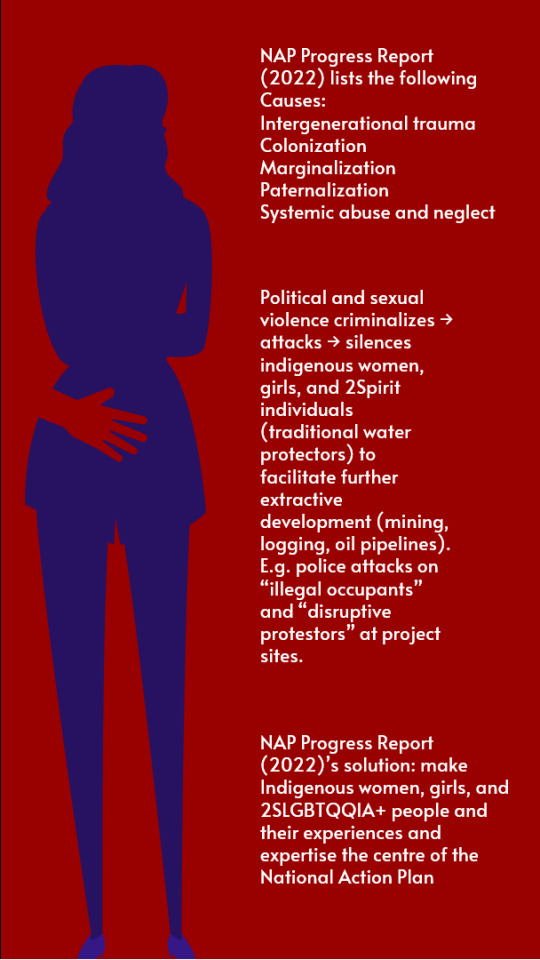


Just some incomplete notes as a friendly reminder that
May 5th is National Day of Awareness for Missing and Murdered Indigenous Women, February 14th is the date for MMIW Marches across Canada, and October 4th is the day of Vigil for our stolen sisters
MMIW also includes girls as young as infants, and gender diverse individuals → MMIWG2S+
While government organizations appear to be raising awareness, creating National Action Plans and declaring National Emergencies, police are complicit in kidnapping and murdering our people wether through acts of violence (for personal gratification or to enable further extractive development which increases raises risk factors) or refusal to investigate (due to jurisdictional issues, to cover it up, or because they’re conditioned to believe that our deaths aren’t worth explaining and that our lives don’t matter).
Colonial violence is alive and well, and it’s up to each and every one of us to contribute to meaningful changes to protect our women, girls, and 2SLGBTQQIA+ people.
There are tons of resources for learning more, but I highly recommend checking out Sovereign Bodies Institute at https://www.sovereign-bodies.org/
43 notes
·
View notes
Text
Environmental Victory for Alaska Natives
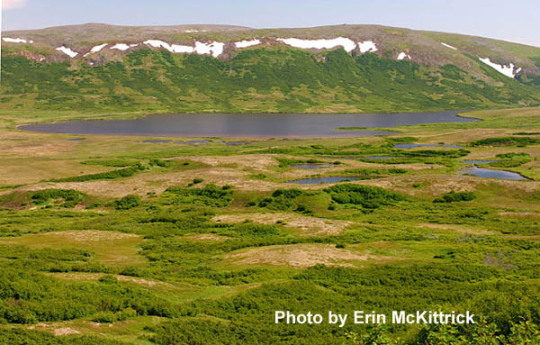
On January 8th, the U.S. Supreme Court rejected the State of Alaska's bid to fast-track the legal process, overrule the Environmental Protection Agency (EPA), and gain approval for the Pebble Mine -- slated to extract enormous amounts of copper, gold, and molybdenum from the pristine and sensitive ecosystem known as Bristol Bay. Located in a remote, wild, and generally uninhabited part of Southwest Alaska, Pebble is the largest known undeveloped copper ore body in the world.
The populations in the area rely heavily on wild resources for subsistence, harvesting moose, caribou and salmon. Wild resources play an important part in the region's cultural heritage. There are more than 30 Alaskan native tribes in the region that depend on salmon to support their traditional subsistence ways of life, in addition to other inhabitants and tourists in the area. A diverse coalition led by Alaska Natives has consistently fought against the proposed mine for more than two decades. It eventually gained support from the EPA, which ultimately blocked the mine proposal in January 2023 over concerns it would threaten an aquatic ecosystem supporting the world's most prolific sockeye salmon fishery.
This decision is significant, particularly considering the current High Court's tendency to support states' rights, limits on regulation -- especially of the environmental variety -- and corporate concerns. Alaska's request, filed in June, was unusual in that it sought to skip lower appeals courts to challenge the EPA's decision on the basis that it violated Alaska's state sovereignty.
Under the law, alleged violations of state sovereignty are one of the few categories of cases that grant the Supreme Court original jurisdiction -- meaning a state can bypass the usual state/federal court appeals process and file straight with the High Court. The justices could easily have decided to hear the case and decide in favor of the mining company, which has shown no qualms about engaging in some shady business practices over the years.
As the single most productive sockeye salmon fishery in the world, Bristol Bay contains biodiversity and abundant wild fish populations which present a stark contrast to many other fisheries in the Pacific Northwest (and worldwide). All five Eastern Pacific salmon species spawn in Bristol Bay's freshwater tributaries. Most have experienced severe depletion over the last few decades. Sockeye salmon, like all Pacific Salmon, are a keystone species, vital to the health of an entire ecosystem. Of course, salmon also provide a sacred food source for Indigenous communities up and down the West Coast.
Kudos to the United Tribes of Bristol Bay, a consortium of Alaska Native tribes fighting to preserve the traditional Yup'ik, Dena'ina, and Alutiiq ways of life in Southwest Alaska, for leading the charge. The Supreme Court's decision confirms all the hard work put in by tribes and allies, including the Save Bristol Bay Coalition. It remains to be seen whether Alaska's conservative leadership will continue with legal challenges at a lower court level -- but, for now, Indigenous People have won a big battle in this decades-long fight to protect their homelands.
9 notes
·
View notes
Text
my bibliography continues to metastasize
the “Jud” section alone is now 145 pages, the “Civil R–Ck” section now 61 pages
was it a waste of time to patiently copy, label, and refactor the Judiciary Acts of 1789, 1793, 1801, 1802, 1803, 1839, 1866, 1869, 1872, and 1875?
was it a waste of time to identify, reformat, and link every case on circuit court diversity jurisdiction in the relevant bit of the Revised Statutes?
and put the two together?
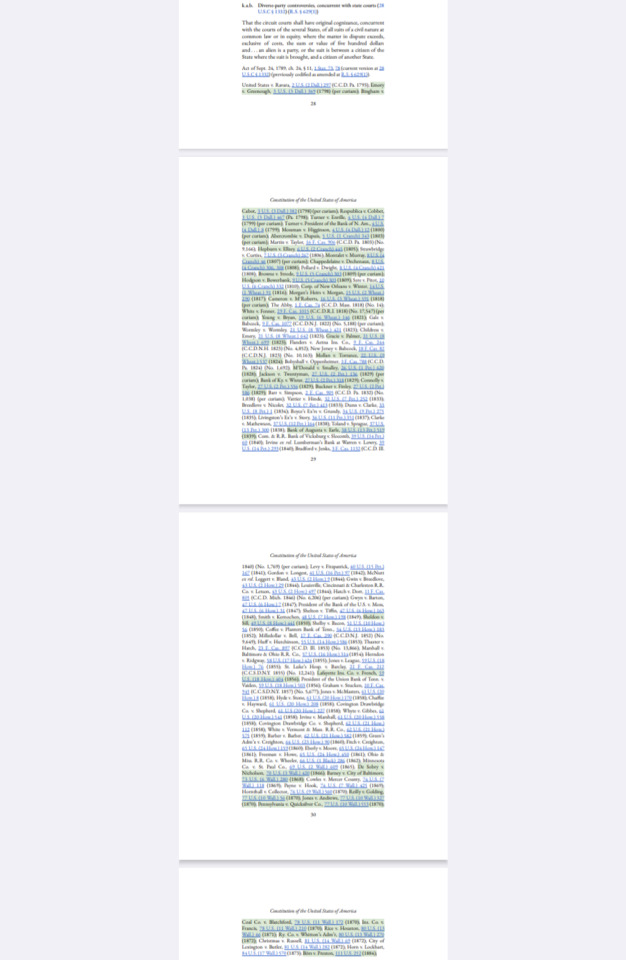
almost certainly, yes
but it makes me so happy to put them together, and to look at them, and to have a place to put my little references and cross-references
I just think law is neat
7 notes
·
View notes
Text
on the prevalence of bounty hunters in the gffa
I’m not sure George Lucas intended bounty hunters to become as prominent as they are in the Star Wars universe. It might just be a consequence of Boba Fett Armour Rad ✨, like the invention of the Mandalorians. However, thinking about the Galactic Republic, it does make sense that there would be a lot of bounty hunters running around fulfilling a particular societal need.
The Galactic Republic’s structure is difficult to pin down because it doesn’t have a clear real world parallel. While it’s usually the United Nations or USA that are brought up, I suggest that its closest structural equivalent is the European Union; single currency, open boarders, high degree of internal autonomy while members are still meant to be bound by the laws and rulings of the higher courts and legislature, multitude of languages and cultures, states have the right cede unilaterally without requiring permission from the central authority. There are still differences though, and the one relevant to this discussion is that we aren’t shown a Republic equivalent of Europol, or the better-known Interpol. During the prequels era there are the Republic Judicial Forces and Jedi Order, but both these organisations provide specialist and crisis assistance rather than dealing with the day-to-day dealings of local planetary and system law enforcement systems. Nobody is calling the Jedi because someone skipped off-planet rather than front-up to court after crashing their speeder through a sixth-story window. Even if local law enforcement were inclined to do such a thing it wouldn’t be permissible, because the number of Jedi and Judicials is tiny compared to the overall population of the Republic.
I think the Republic logically should have an equivalent of Interpol, which I call the Intersector Security Bureau so it can keep its acronym when it is transformed into the Imperial Security Bureau. Given how easy it appears for anybody who owns a private starship to planet-hop undetected, facilitating information exchange must be hugely important. Still, the fact that so far as I can recall the ISB is never mentioned before the Republic becomes the Empire suggests that its reach is limited before Palpatine starts beefing it up. The Jedi do a lot of investigating but mostly rely on their own resources or liaise with the local planetary authorities.
There are a few reasons why an early ISB space!Interpol equivalent might have less prominence and reach than RL!Interpol. One is that it is affected by the same resources sap as the Judicial Forces; losing work to the Jedi Order and funding to local planetary or sector law enforcement. Another is that the Republic’s diverse array of species and cultures creates a complicated environment for hashing out the cultural consensus necessary for the level of understanding and trust required for agreeing to carry out other agencies’ arrest warrants. For example, the Republic’s de facto age of majority – the minimum age at which a person can hold Republic public office, like a become a Senator – is sixteen. This is not an age of majority that member systems of the Republic are required to adhere to in any way; having species with wildly different lifespans and lifecycles like wookiees, trandoshans, and ruurians makes trying to enforce a single age of majority a terrible idea. But that means that you have a planet like Naboo, where Padme Amidala can be employed in the political office of Princess of Theed when she is nine, under the same government as Alderaan, where the heir to the throne doesn’t step up into their full public role until they come of age at sixteen. Other points of difference – attitudes to gambling, recreational drug usage, corporal punishment, reasonable person tests, etc. – create a plethora of friction points between legal jurisdictions.
Then there’s the issue that many of the planets in the Republic aren’t going to trust the governments of every other planet in the Republic. RL!Interpol is facing controversy regarding the accusation that some countries like China have been submitting warrants for arrest on people who are actually political dissidents. In the Republic that translates to, for example, corporate-controlled planets putting out warrants on whistle-blowers calling out the companies’ fraud, environmental regulation violations, debt slavery, etc.
So, if you can’t rely on intersector law enforcement cooperation to retrieve your dangerous driver before any more speeders become wedged through the windows of high-rise apartments, what do you do? You put a bounty on them.
This implies that mainstream socially respectable bounty hunting is quite different from the “I can bring you in hot or I can bring you in cold” business the Mandalorians engage in. Reputable law enforcement agencies will only want their bounties hot and minimally injured; the idea is to get criminals back so they can be tried and punished in accordance with your law. And what if a bounty hunter screws up the bounty you posted and grabs the wrong person? If they’re alive you can stick them on a shuttle back to the planet they were kidnapped from, but if they’re dead that’s a PR nightmare and now you need to chase after that bounty hunter to charge them for murder.
Looking back a couple of millennia from the Post-Ruusan Republic to the Old Republic, many of these forces are still in play. One example of a deficit in law enforcement cooperation that I found particularly memorable was Miel Muwn of the Sullustan Constable Brigade from the Smuggler class story, who personally travelled to Coruscant in pursuit of the stolen Murustavan Ruby where he deputised two Very Upstanding Lawful Citizens to aid him rather than collaborate with the Coruscanti authorities.
Additionally, the division of the galaxy between the Republic and the Sith Empire creates another reason for those governments to work through bounty hunters. Because the Republic and the Empire are either in a state of hot or cold war, they obviously aren’t cooperating on issues like intergalactic crime. If either power wants to arrest someone who has fled into the other’s territories, the most legal least likely to spark violent conflict option available to them is to hire a third party (it’s still not very legal or unlikely to end in violence). Hence, bounty hunters everywhere.
…there are so many ways that this dysfunctional excuse for a system would produce bad outcomes.
#Meanwhile in a Galaxy Far Far Away#star wars meta#swtor meta#bounty hunters#the Galactic Republic#star wars prequels#star wars the old republic
59 notes
·
View notes
Text
As New York City and Washington D.C. feud with the governors of Texas and Arizona over the border states’ busing of migrants to their cities, their own sanctuary city policies are the subject of a reignited debate -- as the Republican governors cite the liberal policies as justification for the buses.
Thousands of migrants have been sent from Texas and Arizona to the two Democratic-run cities, both of which have repeatedly proclaimed and reaffirmed their commitment to protecting illegal immigrants from deportation and making their states welcoming havens.
"Sanctuary" jurisdictions refer to cities or states that restrict local law enforcement from cooperating with federal immigration agencies. Such cities and states will often also move to abolish any distinction between legal and illegal immigration.
After the 2016 election, D.C. Mayor Muriel Bowser reaffirmed the city’s status, saying "we celebrate our diversity and respect all DC residents no matter their immigration status."
NYC NAMED ‘WORST’ SANCTUARY CITY AMID BATTLE WITH TEXAS ON MIGRANT BUSING
Adams said in 2019: "To anyone in the world fleeing hatred and oppression, the ultimate city of immigrants wants you to remember: you’re ALWAYS welcome here."
"‘We should protect our immigrants.’ Period," he tweeted in 2021 when campaigning. "Yes, New York City will remain a sanctuary city under an Adams administration."
But Texas and Arizona began sending buses of migrants to Washington D.C. this Spring, and Texas has recently started sending buses to New York City as well. A waiver form given to migrants says that New York City "has been designated as a sanctuary city by its City Council, and is providing shelter and food to migrants who have entered the country."
While the numbers being sent, just over 10,000 so far, are dwarfed by those encountered at the border, which number around 200,000 each month, the mayors have slammed the moves by the border states -- while calling for federal aid.
Bowser has repeatedly called for the deployment of the National Guard, while describing the migrant influx as a "humanitarian crisis."
"The number of people crossing the border seeking asylum, we expect only to go up, and we need to make sure there is a national response," Bowser said.
Adams has also called for federal help: "We just need help. We need help," he said earlier this month, while also taking aim at Abbott.
"He is an anti-American governor that is really going against everything we stand for. And I am going to do everything feasible to make sure the people of Texas realize how harmful he is to us globally," he said of Abbott.
But border officials have noted the sanctuary city status, with officials in Texas citing it -- along with other border policies -- to justify sending the migrants to the places where they are more welcome.
MIGRANT ENCOUNTERS AT SOUTHERN BORDER SMASH NUMBERS SENT TO NYC, DC
"It's just interesting to see some of these mayors who have invited and have created sanctuary cities to suddenly start complaining that they've got a few thousand immigrants when we're dealing with millions," Attorney General Ken Paxton said on "Fox and Friends."
"New York is a sanctuary city. Mayor Adams said they welcome in illegal immigrants, but now that they have to deal with the reality of it they’re suddenly flummoxed and cannot handle it," Abbott said in an interview with "The Faulkner Focus."
Neither the D.C. or New York City mayors’ offices responded to requests for comments from Fox News Digital about whether they are reconsidering their sanctuary policies given the migrant surge. But Adams in particular has touted what he sees as a more welcoming response from the City.
"Unlike the governor of Texas, who did what I believe is anti-American. I did the opposite and those asylum seekers were happy to hear that the mayor of the City of New York was standing there and stating, 'We're going to treat you with dignity.'" he said last week.
Former acting Immigration and Customs Enforcement (ICE) Director Thomas Homan told Fox News Digital that he welcomed the pressure being placed on the two liberal cities, and said both cities vigorously opposed ICE’s efforts to get criminal illegal immigrants off the city when he was running the agency.
"We had a staff on Rikers Island [prison complex] for years, and they even kicked us out of Rikers Island," he said.
"Extremely uncooperative," he said of NYC. "D.C. was the same, meetings with them...we came out with nothing. They didn’t want to hear it,"
He also cited certain policies from New York City in addition to the sanctuary policies, including barring the term "illegal alien" and giving illegal immigrants drivers’ licenses and other assistance that he says already encourages migrants to go to the Big Apple.
"Who the hell wouldn’t go to New York?" Homan said. "I think New York ranks third in illegal alien population behind Los Angeles and Chicago --they're already going to New York."
He says that now he welcomes Abbott’s moves, saying it raised the issue of sanctuary cities in the mainstream media -- where such policies are again being talked about.
"I also think he's calling out politicians for claiming to be sanctuary cities because it's good for their political careers – but when you actually give them people, put people in their welcoming communities, they're pushing back against it," he said.
Homan added that he hopes it will add pressure to the White House on its border policies as well, which he and other former Trump officials have blamed for exacerbating the crisis at the border.
"I think Governor Abbott's taking a stab at raising the temperature and trying to get attention on the subject and hopefully pushing the White House to take some action," he said. "I think what he's doing is great."
#nunyas news#they never really thought they'd have to#act on their claims about their cities#stepped in it big time there dudes
129 notes
·
View notes